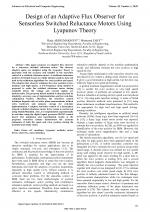| 2/2020 - 14 |
Design of an Adaptive Flux Observer for Sensorless Switched Reluctance Motors Using Lyapunov TheoryABDELMAKSOUD, H. |
| Extra paper information in |
| Click to see author's profile in |
| Download PDF |
Author keywords
AC machines, Lyapunov methods, motor drives, observers, state estimation
References keywords
reluctance(27), switched(26), sensor(22), position(20), motor(15), control(15), electronics(13), applications(13), power(12), estimation(11)
Blue keywords are present in both the references section and the paper title.
About this article
Date of Publication: 2020-05-31
Volume 20, Issue 2, Year 2020, On page(s): 123 - 130
ISSN: 1582-7445, e-ISSN: 1844-7600
Digital Object Identifier: 10.4316/AECE.2020.02014
Web of Science Accession Number: 000537943500014
SCOPUS ID: 85087447190
Abstract
This paper proposes an adaptive flux observer for a sensorless switched reluctance motor. The observer adaptive gains are designed using the Lyapunov theory to guarantee both the accuracy and stability of the sensorless control of a switched reluctance motor. A nonlinear inductance model is developed based on a finite element analysis data and used in the estimation algorithms for rotor position and speed. The adaptive flux observer estimates the rotor position at low, medium, and high speeds. A low-frequency ramp method is proposed to excite the switched reluctance motor during standstill where the voltage and current signals are unobservable. The proposed hybrid method is characterized by simplicity, accuracy, ease of implementation, and low real-time computation burden. Therefore, the sensorless control technique depends only on active phase measurements without extra hardware and memory storage for real-time implementation. Complete sensorless control of a three-phase 6/4-pole switched reluctance motor drive system is carried out using Matlab/Simulink. Also, it is implemented experimentally in real-time using the digital signal processor-DS1102 control board. The simulation and experimental results of the proposed sensorless scheme demonstrate the accurate estimation of both the speed and rotor position during the transient and steady states. |
| References | | | Cited By |
Web of Science® Times Cited: 6 [View]
View record in Web of Science® [View]
View Related Records® [View]
Updated 3 weeks, 2 days ago
SCOPUS® Times Cited: 7
View record in SCOPUS® [Free preview]
View citations in SCOPUS® [Free preview]
[1] Research on Torque Ripple Minimization of Double-stator Switched Reluctance Motor Using Finite Element Method, Das GUPTA, T., CHAUDHARY, K., Advances in Electrical and Computer Engineering, ISSN 1582-7445, Issue 4, Volume 21, 2021.
Digital Object Identifier: 10.4316/AECE.2021.04015 [CrossRef] [Full text]
[2] Rotor Position Estimation Approaches for Sensorless Control of Permanent Magnet Traction Motor in Electric Vehicles: A Review, Li, Yong, Wu, Hao, Xu, Xing, Sun, Xiaodong, Zhao, Jindong, World Electric Vehicle Journal, ISSN 2032-6653, Issue 1, Volume 12, 2021.
Digital Object Identifier: 10.3390/wevj12010009 [CrossRef]
[3] Phase flux linkage estimation of external rotor switched reluctance motor with NARX neural network, Aydemir, Mustafa, Okumus, Halil Ibrahim, Electrical Engineering, ISSN 0948-7921, Issue 2, Volume 105, 2023.
Digital Object Identifier: 10.1007/s00202-022-01726-x [CrossRef]
[4] An Overview of Position Sensorless Techniques for Switched Reluctance Machine Systems, Tang, Xingtao, Sun, Xiaodong, Yao, Ming, Applied Sciences, ISSN 2076-3417, Issue 7, Volume 12, 2022.
Digital Object Identifier: 10.3390/app12073616 [CrossRef]
[5] Stator flux based-MRAS position/speed observer of sensorless switched reluctance motor drives including startup operation, Maksoud, Hady Abdel, Zaky, Mohamed S., Ain Shams Engineering Journal, ISSN 2090-4479, Issue 1, Volume 16, 2025.
Digital Object Identifier: 10.1016/j.asej.2024.103199 [CrossRef]
Disclaimer: All information displayed above was retrieved by using remote connections to respective databases. For the best user experience, we update all data by using background processes, and use caches in order to reduce the load on the servers we retrieve the information from. As we have no control on the availability of the database servers and sometimes the Internet connectivity may be affected, we do not guarantee the information is correct or complete. For the most accurate data, please always consult the database sites directly. Some external links require authentication or an institutional subscription.
Web of Science® is a registered trademark of Clarivate Analytics, Scopus® is a registered trademark of Elsevier B.V., other product names, company names, brand names, trademarks and logos are the property of their respective owners.
Faculty of Electrical Engineering and Computer Science
Stefan cel Mare University of Suceava, Romania
All rights reserved: Advances in Electrical and Computer Engineering is a registered trademark of the Stefan cel Mare University of Suceava. No part of this publication may be reproduced, stored in a retrieval system, photocopied, recorded or archived, without the written permission from the Editor. When authors submit their papers for publication, they agree that the copyright for their article be transferred to the Faculty of Electrical Engineering and Computer Science, Stefan cel Mare University of Suceava, Romania, if and only if the articles are accepted for publication. The copyright covers the exclusive rights to reproduce and distribute the article, including reprints and translations.
Permission for other use: The copyright owner's consent does not extend to copying for general distribution, for promotion, for creating new works, or for resale. Specific written permission must be obtained from the Editor for such copying. Direct linking to files hosted on this website is strictly prohibited.
Disclaimer: Whilst every effort is made by the publishers and editorial board to see that no inaccurate or misleading data, opinions or statements appear in this journal, they wish to make it clear that all information and opinions formulated in the articles, as well as linguistic accuracy, are the sole responsibility of the author.



